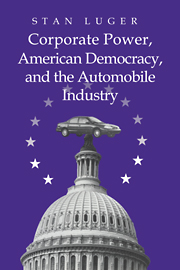Book contents
- Frontmatter
- Contents
- Acknowledgments
- Introduction
- 1 Studying Power in America
- 2 The Structure of the Auto Industry
- 3 Corporate Political Hegemony and Its Decline: 1916–1966
- 4 The Politics of Compromise: 1967–1978
- 5 The Resurgence of Corporate Power: 1979–1981
- 6 The Triumph of Corporate Power: Regulatory Policy, 1981–1988
- 7 The Triumph of Corporate Power: Trade Policy, 1981–1985
- 8 Interregnum: 1989–1996
- Conclusion: Corporate Power and American Democracy
- Index
6 - The Triumph of Corporate Power: Regulatory Policy, 1981–1988
Published online by Cambridge University Press: 08 October 2009
- Frontmatter
- Contents
- Acknowledgments
- Introduction
- 1 Studying Power in America
- 2 The Structure of the Auto Industry
- 3 Corporate Political Hegemony and Its Decline: 1916–1966
- 4 The Politics of Compromise: 1967–1978
- 5 The Resurgence of Corporate Power: 1979–1981
- 6 The Triumph of Corporate Power: Regulatory Policy, 1981–1988
- 7 The Triumph of Corporate Power: Trade Policy, 1981–1985
- 8 Interregnum: 1989–1996
- Conclusion: Corporate Power and American Democracy
- Index
Summary
By the time Ronald Reagan took office in January 1981, few questioned that the auto industry was in crisis. In 1980, the industry as a whole had reeled from record losses of $4.2 billion. By contrast, in every year of the previous two decades, the automakers' combined profits were never less than $2 billion (1980 dollars). Meanwhile, GM sustained its first loss since 1921. With the shift in automotive policy under Jimmy Carter and the subsequent election of a stridently probusiness president whose own victory was, in part, a reflection of the business mobilization of the 1970s, the automakers were in a position to obtain wholesale changes in public policy. The industry's economic troubles were turned into a political advantage. In April, 1981, Reagan announced a comprehensive plan to aid the industry that included extensive regulatory rollbacks, discussions leading to import quotas on Japanese cars, and the relaxation of antitrust policy. The industry's reaction, noted one reporter, “bordered on euphoria.”
Central to this plan was the rollback of thirty-four safety, emissions, and fuel economy regulations. Standards that had been contested and often delayed but in the end promulgated, were now fair game. What the industry previously had been unable to block it was now able to reverse. To document the Reagan-era policy approach, one policy from each of the three main automotive regulatory areas – safety, emissions, and fuel economy – will be examined. The three examples are the CAA Amendments of 1981 (emissions), the air bag rollback (safety), and the rollback of fuel economy (CAFE) requirements.
- Type
- Chapter
- Information
- Corporate Power, American Democracy, and the Automobile Industry , pp. 113 - 134Publisher: Cambridge University PressPrint publication year: 1999



